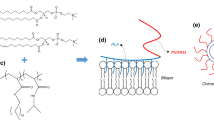Abstract
Stimuli-responsive nanosystems are an emerging technology in the field of therapy and are very promising for various applications, including targeted drug delivery. In this chapter, our scope is to integrate two different methodologies, namely differential scanning calorimetry (DSC) and dynamic light scattering (DLS), in order to rationally approach the functional behavior of thermoresponsive chimeric/mixed liposomes and interpret their thermoresponsiveness on a thermodynamic basis. In particular, chimeric bilayers comprised of the phospholipid 1,2-dipalmitoyl-sn-glycero-3-phosphocholine (DPPC) and two different-in-composition thermoresponsive amphiphilic block copolymers poly(N-isopropylacrylamide)-b-poly(lauryl acrylate) (PNIPAM-b-PLA) 1 or 2 were built by a conventional evaporation technique, followed by DSC, and chimeric liposomes of DPPC and PNIPAM-b-PLA 1 were developed and studied by DLS, after preparation and after a simple heating protocol. The results from both methodologies indicate the composition- and concentration-dependent lyotropic effect of the foreign copolymer molecule on the properties and functionality of the lipidic membrane.
Access this chapter
Tax calculation will be finalised at checkout
Purchases are for personal use only
Similar content being viewed by others
References
Sánchez-Moreno P, de Vicente J, Nardecchia S et al (2018) Thermo-sensitive nanomaterials: recent advance in synthesis and biomedical applications. Nanomaterials (Basel) 8:935–966
Demetzos C, Pippa N (2014) Advanced drug delivery nanosystems (aDDnSs): a mini-review. Drug Deliv 21:250–257
Naziris N, Pippa N, Pispas S et al (2016) Stimuli-responsive drug delivery nanosystems: from bench to clinic. Curr Nanomed 6:1–20
Lee Y, Thompson DH (2017) Stimuli-responsive liposomes for drug delivery. Wiley Interdiscip Rev Nanomed Nanobiotechnol 9(5):e1450
Lee SM, Nguyen ST (2013) Smart nanoscale drug delivery platforms from stimuli-responsive polymers and liposomes. Macromolecules 46:9169–9180
Futscher MH, Philipp M, Müller-Buschbaum P et al (2017) The role of backbone hydration of poly(n-isopropyl acrylamide) across the volume phase transition compared to its monomer. Sci Rep 7:17012–11731
Liu R, Fraylich M, Saunders BR (2009) Thermoresponsive copolymers: from fundamental studies to applications. Colloid Polym Sci 287:627–643
Lanzalaco S, Armelin E (2017) Poly(n-isopropylacrylamide) and copolymers: a review on recent progresses in biomedical applications. Gels 3:36–67
Pippa N, Meristoudi A, Pispas S et al (2015) Temperature-dependent drug release from DPPC:C12H25-PNIPAM-COOH liposomes: control of the drug loading/release by modulation of the nanocarriers’ components. Int J Pharm 485:374–382
Chountoulesi M, Kyrili A, Pippa N et al (2017) The modulation of physicochemical characterization of innovative liposomal platforms: the role of the grafted thermoresponsive polymers. Pharm Dev Technol 22:330–335
Naziris N, Pippa N, Pispas S et al (2017) The thermal analysis of liposomal formulations as an element to evaluate their effectiveness as drug and vaccine delivery systems. In: Pearson BR (ed) Liposomes: historical, clinical and molecular perspectives. NOVA, USA. (Chapter 10)
Pippa N, Pispas S, Demetzos C (2016) Physicochemical characterization and basic research principles of advanced drug delivery nano systems (aDDnSs). In: Tiwari A, Misha YK, Kobayashi H, APF T (eds) Intelligent nanomaterials, 2nd edn. Wiley-Scrivener Publishing LLC, New Jersey, MA. (Chapter 5)
Demetzos C (2015) Biophysics and thermodynamics: the scientific building blocks of bio-inspired drug delivery nano systems. AAPS PharmSciTech 16:491–495
Naziris N, Pippa N, Stellas D et al (2018) Development and evaluation of stimuli-responsive chimeric nanostructures. AAPS PharmSciTech 19:2971–2989
Wischke C, Schwendeman SP (2008) Principles of encapsulating hydrophobic drugs in PLA/PLGA microparticles. Int J Pharm 364:298–327
You K, Wen G, Skandalis A et al (2019) Anion specificity effects on the interfacial aggregation behavior of poly(lauryl acrylate)-block-poly(N-isopropylacrylamide). Langmuir 35:9904–9911
Acknowledgments
The research work was supported by the Hellenic Foundation for Research and Innovation (HFRI) and the General Secretariat for Research and Technology (GSRT), under the HFRI PhD Fellowship grant (GA. no. 392).
This work has been co-financed by the European Union and Greek national funds through the program “Support for Researchers with Emphasis on Young Researchers” (call code: EDBM34, ΚΕ 14995) and under the research title “Preparation and study of innovative forms of administration of pharmaceutical molecules targeting at improved pharmacological properties.”
Author information
Authors and Affiliations
Corresponding authors
Editor information
Editors and Affiliations
Rights and permissions
Copyright information
© 2021 Springer Science+Business Media, LLC, part of Springer Nature
About this protocol
Cite this protocol
Naziris, N., Skandalis, A., Mavromoustakos, T., Pispas, S., Demetzos, C. (2021). Association of the Thermodynamics with the Functionality of Thermoresponsive Chimeric Nanosystems. In: Mavromoustakos, T., Tzakos, A.G., Durdagi, S. (eds) Supramolecules in Drug Discovery and Drug Delivery. Methods in Molecular Biology, vol 2207. Humana, New York, NY. https://doi.org/10.1007/978-1-0716-0920-0_17
Download citation
DOI: https://doi.org/10.1007/978-1-0716-0920-0_17
Published:
Publisher Name: Humana, New York, NY
Print ISBN: 978-1-0716-0919-4
Online ISBN: 978-1-0716-0920-0
eBook Packages: Springer Protocols




